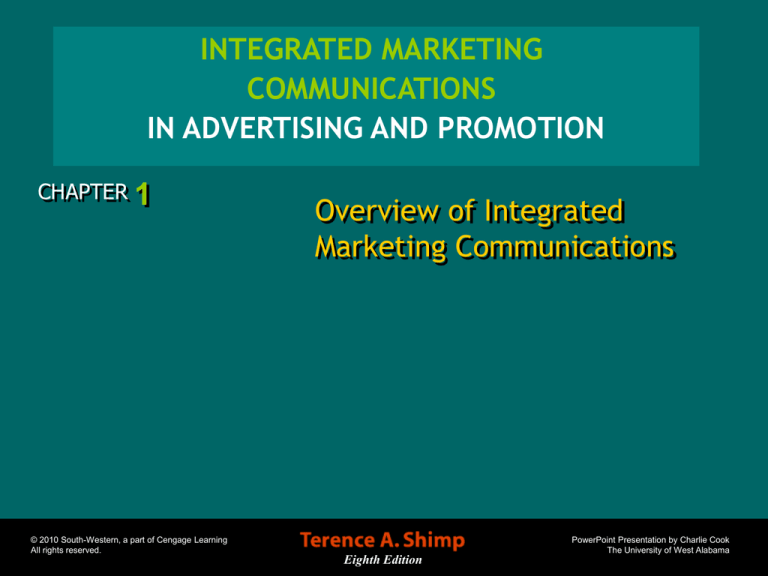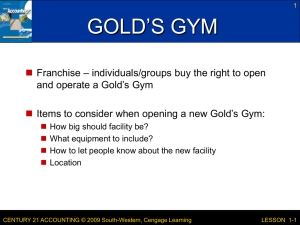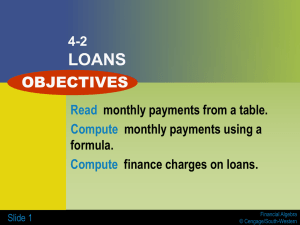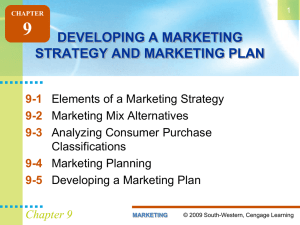
INTEGRATED MARKETING
COMMUNICATIONS
IN ADVERTISING AND PROMOTION
CHAPTER 1
Overview of Integrated
Marketing Communications
© 2010 South-Western, a part of Cengage Learning
All rights reserved.
PowerPoint Presentation by Charlie Cook
The University of West Alabama
Eighth Edition
Chapter Objectives
After reading this chapter you should be able to:
1. Appreciate the practice of marketing communications and
recognize the marcom tools used by practitioners.
2. Describe the philosophy and practice of integrated marketing
communications (IMC).
3. Understand the five key features of IMC.
4. Recognize the activities involved in developing an integrated
communications program.
5. Identify obstacles to implementing an IMC program.
6. Understand and appreciate the components contained in an
integrative model of the marcom decision-making process.
© 2010 South-Western, a part of Cengage Learning. All rights reserved.
1–2
Introduction to Marketing Communications
(Marcom)
Integrated Marketing
Communication (IMC)
Programs
Business-to-Consumer
(B2C)
Business-to-Business
(B2B)
© 2010 South-Western, a part of Cengage Learning. All rights reserved.
Integrated Marcom
B2C&B
1–3
Table 1.1
The Tools of Marketing Communications
1. Media Advertising
• TV
• Radio
• Magazines
• Newspapers
2. Direct Response and
Interactive Advertising
• Direct mail
• Telephone solicitation
• Online advertising
3. Place Advertising
• Billboards and bulletins
• Posters
• Transit ads
• Cinema ads
4. Store Signage and Point-ofPurchase Advertising
• External store signs
• In-store shelf signs
• Shopping cart ads
• In-store radio and TV
5. Trade- and ConsumerOriented Promotions
• Trade deals and buying
allowances
• Display and advertising
allowances
• Trade shows
• Cooperative advertising
• Samples
• Coupons
• Premiums
• Refunds/rebates
• Contests/sweepstakes
• Promotional games
• Bonus packs
• Price-off deals
6. Event Marketing and
Sponsorships
• Sponsorship of sporting
events
• Sponsorship of arts, fairs,
and festivals
• Sponsorship of causes
7. Marketing-Oriented Public
Relations and Publicity
8. Personal Selling
Source: Adapted from Figure 1.1 in Kevin Lane Keller, “Mastering the Marketing Communications Mix: Micro and Macro Perspectives
on Integrated Marketing Communication Programs,” Journal of Marketing Management 17 (August, 2001), 823–851.
© 2010 South-Western, a part of Cengage Learning. All rights reserved.
1–4
The Integration of Marketing
Communications
• Why Not Integrated?
Tradition of separation communication tools
Influence of specialized outside suppliers (read pg9)
Managerial parochialism
Fear of budget cutbacks
Loss of power and authority
Resistance of outside suppliers to broadening their
functions
Skeptics who consider IMC to be a fad
© 2010 South-Western, a part of Cengage Learning. All rights reserved.
1–5
The Integration of Marketing
Communications (cont’d)
• IMC and Synergy
Using multiple communication tools in conjunction
with one another can produce greater results
(synergistic effects) than tools used individually and
in an uncoordinated fashion.
© 2010 South-Western, a part of Cengage Learning. All rights reserved.
1–6
And Now a Definition of IMC
• Integrated Marketing Communications (IMC)
• Is a communications process for planning, creation, integration,
and implementation of diverse forms of marcom delivered to a
brand’s targeted customers and prospects
• Has as its goal influencing or affecting behavior of targeted
audience
• Considers all touch points a customer/ prospect has with the brand
as potential delivery channels for messages
• Requires that all of a brand’s communication media deliver a
consistent message
• Has customer/prospect as its starting point for determining types of
messages and media to inform, persuade, and induce action
© 2010 South-Western, a part of Cengage Learning. All rights reserved.
1–7
Table 1.2
Five Key Features of IMC
1. Start with the customer or prospect.
2. Use any form of relevant contact or touch point.
3. Speak with a single voice.
4. Build relationships.
5. Affect behavior.
© 2010 South-Western, a part of Cengage Learning. All rights reserved.
1–8
Key IMC Feature # 1
• The Consumer or Business Customer Must
Represent the Starting Point for All Marketing
Communications Activities
• Takeaway:
Consumers in Control
Outside-in approach: learn the media preferences and
lifestyles of customers/prospects to know the best contexts to
reach them with brand messages.
Reduced Dependence on Mass Media
Consumers are increasingly in control of their media choices
for acquiring information about brands.
© 2010 South-Western, a part of Cengage Learning. All rights reserved.
1–9
Selecting the Appropriate Marcom Tools
Media-Neutral
Approach
Identify Marcom
Program Goals
Courtesy of WISK®, Unilever United States, Inc.
Determine Best
Way to Allocate
Marketing Budget
© 2010 South-Western, a part of Cengage Learning. All rights reserved.
1–10
Key IMC Feature # 2
• Use Any and All Marcom Tools
That Are Up to the Task
• Takeaway:
360-Degree Branding
A brand’s touch points should be
everywhere the target audience is.
Not All Touch Points
Are Equally Engaging
Surround customers/prospects
with the message, but not to the
point of being irritatingly present.
© 2010 South-Western, a part of Cengage Learning. All rights reserved.
1–11
Key IMC Feature # 3
• Multiple Messages Must Speak
with a Single Voice
• Takeaway:
A brand’s positioning statement must:
Present a clear idea of the
brand in its target market’s mind
Consistently deliver the same
unified message across all
media channels on all occasions.
© Richard B. Levine / Newscom
© 2010 South-Western, a part of Cengage Learning. All rights reserved.
1–12
Key IMC Feature # 4
• Build Relationships Rather
Than Engage in Flings
• Takeaway:
Loyalty programs promote long-
term relationships between
customers and brands that lead
to customer retention.
Experiential marketing programs
can create brand experiences
that make positive and lasting
impressions on customers.
© 2010 South-Western, a part of Cengage Learning. All rights reserved.
1–13
Key IMC Feature # 5
• Don’t Lose Focus of the Ultimate Objective:
Affect Behavior
• Takeaway:
The goal of IMC is to influence the target audience in
such a way that the audience engages in a specific
desired behavior.
The effectiveness of an IMC program is judged by its
success in terms of its ultimate influence on behavior.
© 2010 South-Western, a part of Cengage Learning. All rights reserved.
1–14
Obstacles to Implementing IMC
• Integration requires tight coordination among all
elements of a marcom program.
Few providers of marketing communication services
have the diversity of skills required to execute an IMC
program.
Direct-to-customer advertising is more difficult than a
mass media campaign.
The greatest challenge is making sure that all
marcom tools are consistently executed.
© 2010 South-Western, a part of Cengage Learning. All rights reserved.
1–15
Marketing Communications
• Marketing Communications’ Objective
To enhance brand equity by moving customers to
favorable action toward the brand—trying it, repeat
purchasing it, and becoming loyal toward the brand.
• Brand Equity
The degree to which consumers favorably perceive
the brand’s features and benefits as compared to
competitive brands and how strongly these views are
held in memory
© 2010 South-Western, a part of Cengage Learning. All rights reserved.
1–16
Figure 1.1
Making Brand-Level Marcom Decisions and Achieving
Desired Outcomes
© 2010 South-Western, a part of Cengage Learning. All rights reserved.
1–17
Fundamental Marcom Decisions
Fundamental
Marcom Program
Decisions
Targeting
Positioning
© 2010 South-Western, a part of Cengage Learning. All rights reserved.
Setting
Objectives
Budgeting
1–18
Fundamental Marcom Decisions (cont’d)
Top-down
(TD)
Top-down/Bottom-up
(TD/BU)
Budgeting
Procedures
Bottom-up/Top-down
(BU/TD)
Bottom-up
(BU)
© 2010 South-Western, a part of Cengage Learning. All rights reserved.
1–19
Fundamental Marcom Decisions:
Commit-to-Memory Mantra
All marketing
communications
should be:
1. Directed to a specific
target market
2. Clearly positioned
3. Created to achieve
a specific objective
4. Undertaken within
budget constraints
© 2010 South-Western, a part of Cengage Learning. All rights reserved.
1–20
Marcom Implementation Decisions
Marcom Program
Implementation
Decisions
Mixing
Elements
Creating
Messages
© 2010 South-Western, a part of Cengage Learning. All rights reserved.
Selecting
Media
Establishing
Momentum
1–21
Figure 1.2
A Buy-OneGet-One-Free
Promotion
© 2010 South-Western, a part of Cengage Learning. All rights reserved.
1–22
Marcom Outcomes
Marcom
Outcomes
Enhancing
Brand Equity
© 2010 South-Western, a part of Cengage Learning. All rights reserved.
Affecting
Behavior
1–23
Marcom Program Evaluation
Marcom Program
Implementation
Measuring Results
for Accountability
Behavioral
Impact
Communication
Outcomes
Taking Corrective
Action
Providing
Feedback
© 2010 South-Western, a part of Cengage Learning. All rights reserved.
Greater Investment
Different
Communication
Combinations
Revised Strategy
Revised Allocations
1–24












